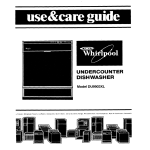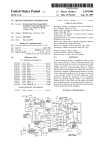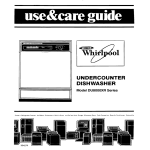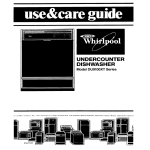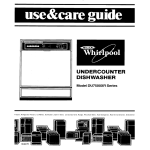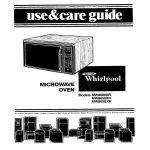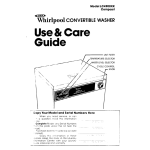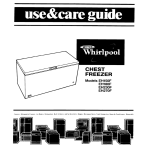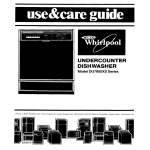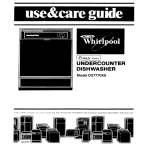Download Whirlpool DU9900XR Specifications
Transcript
i, Freezers. Aefrlgeralor-Freezers. Ice Makers Dishwashers. Bultt-In Ovens. and Surlace Units. Ranges. Microwave Ovens Trash Compactors, Room AII Condltloners Dehumldifif Contents L Page BEFORE YOU USE YOUR DISHWASHER IMPORTANT SAFETY INSTRUCTIONS PARTS AND FEATURES POWER CLEAN’ WASHING SYSTEM, Quiet Operating Tips, PROPER LOADING Top Rack Loading Small Items Basket, Bottom Rack Loading Loading Silverware and Cutlery Baskets ADDING DETERGENT RINSE AID DISPENSER STARTING YOUR DISHWASHER 6 7 7 8 01985 Whirlpool Selecting a Cycle Selecting an Option Changing a Setting Digital Display and Signal Lights To Add a Dish After Starting ENERGY SAVING TIPS SPECIAL TIPS COMMON DISHWASHING PROBLEMS IF YOU NEED SERVICE OR ASSISTANCE I, Before Calling for Assistance 2. If You Need Assistance 3. If You Need Service 4. If You Have a Problem 8 9 10 10 10 11 12 13 15 15 15 15 15 ‘Tmk. Corporation Before you use your dishwasher It is your personal responsibility and obligation to be sure your dishwasher: Is installed by a qualified installer. l Has been installed where it is protected from the elements. l Has been installed on a floor strong enough to support its weight. l Has been properly connected to electricity, water and drain.* l Has been properly electrically grounded.* l Is not used by children or anyone unable to operate it properly. l Is properly maintained. * See installation instructions for complete information. l Parts and features Model DU9900XR Series ADJUSTABLE TOP RACK ,UPPER SPRAY ARM SMALL ITEMS BASKET EXTRA CAPACITY FOLD DOWN SHELVES RACK BUMPE BOTTOM RACK \ SILVERWARE BASKET DETERGENT DISPENSERS LOWER SPRAY ARM 4‘ / CuTmY WATER COLUMN BASKET \ DOOR COLOR PANEL PACK THE OVERFLOW PROTECTOR is designed to prevent too much water from entering the dishwasher. It is not removable. THE POWER CLEAN’ MODULE is designed to keep the wash and rinse water clean. It alS0 grinds up and removes food particles. During grinding, some sounds will be heard. Tmk. Copy your Model and Serial Numbers When you need service or call with a question, have this information ready: I. Complete Model and Serial Numbers(from the plate located as shown). 2. Purchase date from sales slip. Copy this information in these spaces. Keep this book, your warranty and sales slip together in a handy place. here... Model Serial Number Number Purchase oate Service Company and Telephone Number POWER CLEAN* Washing System Your dishwasher cleans by spraying a mixture of hot, clean water and detergent against soiled surfaces of dishes, When a cycle is started, the dishwasher fills with water to about the level of the heating element. This water is pumped through the rotating spray arm&through the POWER CLEAN Module which removes food particle&and back through the rotating spray arms. Soiled water is pumped out and replaced with clean water during a cycle - the number of times depends on the cycle being used. The POWER CLEAN* Module removes food particles from the water, stores them, then washes them down the drain. Load dishes so soiled surfaces face erful spray from rotating arms. Step-saving preparation pow- for washing It is not necessary to rinse dishes before putting them into the dishwasher. Just remove large pieces, bones, and other hard items. The POWER CLEAN* Module will remove food pamcles from the water. It contains a chopping device which will reduce the size of food items. If hard items such as fruit seeds, nuts and egg shells enter the POWER CLEAN’ Module, you Hot water might hear chopping, grinding, crunching or buzzing sounds. Those sounds are normal when hard items enter the module. DO NOT LET METALLIC ITEMS (I.E. POT HANDLE SCREWS) GET INTO THE POWER CLEAN’ MODULE. THIS COULD RESULT IN DAMAGE TO THE POWER CLEAN* MODULE. is a must Hot water dissolves and activates the dishwashing detergent. Hot water dissolves grease on dishes and helps dry glasses spot-free. Make certain loads are washed in hot water (at least 140°F - 60°C). Two ways to have a reliable hot water supply... I. Maintain 140°F water supply at central water heater. To check water temperature, turn on hot water faucet nearest the dishwasher. Let water run until it is as hot as possible, then check with a candy or meat thermometer. If the temperature is too low, have a qualified person raise the water heater thermostat setting. 2. Use HI-TEMP WASHING Option. If water heating is needed, a thermostat will delay the cycle until temperature reaches 145°F (63-C). If water is hot enough, the cycle will proceed with no delay. This lets you turn down your water heater, if you choose, without cutting back on hot water needed for good dish‘Tmk. washing. Quiet operating tips To avoid thumping and clattering noises during operation: l Make sure lightweight load items are secured in the rack. l Make sure pot lids and handles, pizza pans, cookie sheets, etc. do not touch interior walls 4 or interfere with either of the spray arms rotation. l Load dishes so they don’t touch one another. NOTE: Keep slnk drain plugs inserted durlng dlshwasher operation to prevent noise transfer through dmlns. Proper loading Always load dishes so soiled surfaces are reached by spray from rotating Water must be able to drain off completely for best drying results. Be careful items so spray can reach all surfaces. spray arms. to Separate Top rack loading CUP AND GLASS LOAD l l The top rack is designed for cups, glasses and smaller items. . Place so open ends face down for cleaning and draining. . load glasses in top rack only. Bottom rack is not designed for glasses. Damage may occur. l Place items in the rows between prongs. Placing them over the prongs can lead to breakage. Be sure lightweight items are held firmly in place. China, crystal and other delicate items must not touch each other during dishwasher operation. Damage may occur. ADJUSTABLE TOP RACK The top rack does not have to be level. MIXED LOAD R LOWER . Raise or lower one or both sides to help fit tall items in the top or bottom rack. l Turn knob clockwise to raise a side. l Turn knob counterclockwise to lower a side l l l l Load plastic items only in the top rack. Only plastic items marked “dishwasher safe” are recommended. Plastic items can be melted in the bottom rack. Small bowls, pans and other utensils can be placed in the top rack. Items with cooked-on or dried-on foods should be loaded in the bottom rack with soiled surfaces facing the spray. SMALL ITEMS BASKET The basket is designed to hold small items that may otherwise fall through the racks. l Baby bottle collar rings and nipples, napkin holders, bottle caps, can lids, corn cobb holders, etc. EXTRA-CAPACITY FOLD DOWN SHELF Extra shelves on the right and left side of the top rack can be folded down over short items (cups, juice glasses, cereal bowls, etc.) to hold extra items. Adjust rack height if necessary (see above). Bottom rack loading Place plates, soup bowls, etc., between prongs and facing the spray. l Securely place heavily soiled cookware face down in rack. NOTE: . Do not load glasses, cups or plastic items in the bottom rack. l When lower rack is removed, replace with bumpers in front. l l l Load cookie sheets, cake pans and other items at sides or back. Loading items in front may keep water spray from reaching detergent dispenser and silverware basket. Make sure pot handles and other items do not stop rotation of either the upper or lower spray arm. Spray arms must move freely. Loading silverware and cutlery baskets ;yn:tnSns,;t tht;Y Load forks To remove the basket, slide it toward the top of the doorby the handle. Lift it off the holding buttons. Replace it in reverse order. and NO YES gether. Spray can’t reach nested items. Mix items in each section of the basket. Small items - baby bottle caps, jar lids, etc.-can be put in the small items basket in the upper rack. Make sure sharp items (knives, forks, skewers, etc.) are put in point down. The silverware basket can be loaded while it’s in place on the door, or it can be taken out for loading on the 7 counter or table. It can also be removed for easy unloading. Always unload or remove the basket before unloading the racks to avoid spilling water droplets on the silverware. To open the basket, unhook shown. Be sure the cover is completely latched before pulling out the bottom rack and before closing the dishwasher door. Remove and replace cutlery basket in the silverware basket. Use for long items. Remove contents onto a cutting boa to unload. This can help avoid accidents with sharp points and edges. the latch as the same way as the the cutlery basket the basket and tip Adding detergent The kind and amount of dishwasher detergent you use is an important getting your dishes clean. Read this section carefully. Use automatic dlshwasher detergent only. Other detergents are too mild and much too sudsy to work in the dishwasher. Different brands of dishwasher detergent have different amounts of phosphorus. Phosphorus softens water and helps prevent water spots on dishes. If water is hard and phosphorus content is low (8.7% or less), you may need to use more detergent or use a brand with a higher phosphorus content (12% or higher). 1 The detergent detergent dispenser The detergent dispenser has one section with a cover and one without. l Put detergent in both sections for cycles with two washes. l Put detergent in the covered section only for cycles with one wash. l Push the cover down until it is latched. The cover opens automatically when the main wash starts. Detergent in the open section falls into the dishwasher when the door is closed. \ : & -2 I Do not add detergent until you are ready to wash. When using Delay Wash, make sure the detergent dispensers are clean and dry before adding the detergent. Fresh automatic dishwasher detergent is necessary for best washing results. Store detergent tightly in a cool dry place. How much part of COVER -/Use covered section for.. NORMAL WASH cycle LOW ENERGY WASH Cycle CHINA CRYSTAL Cycle COVER LATCH \I-\’ Use both sections for.. POTS & PANS Cycle HEAVY WASH Cycle to use The amount of detergent to use depends on the hardness of your water. If too little is used, dishes won’t be clean. However, if too much is used in soft water, glassware will begin to etch. Find out your waters hardness by asking your local water department, water softener company or county extension agent. l l l HARD-Fill 1 or both sections to top line if water is 8 or more grains of MEDIUM - Fill 1 or both sections to middle line if water is 5 to 7 grains Of SOFT - Fill 1 or both sections to bottom line if water is 0 to 4 grains hardness. Of Rinse aid dispenser A rinse aid helps keep water from forming droplets and drying as spots. Keep the dispenser filled with a rinse aid such as Jet-Dry.@A small amount is released automatically during ths final rinse of each cycle. Check the dispenser periodically to see if it needs refilling. The Fill Indicator Cap shows when it’s time to fill the rinse aid dispenser. When the fill level is low, the center of the cap Will appear to be clear. Keep the dispenser fill cap tightly closed. 7 Starting your dishwasher The controls are behind a tilt-out panel. Just tilt it forward from the top to reach the controls. When it is tilted out, the display - above the controls - will show 2 zeros. The dishwasher is pre-programmed for the NORMAL WASH Cycle and AIR DRY Option. If your want this cycle, just touch START. To select a different cycle and option, just touch the desired pad. The Signal Light on the pad will come on to show the cycle about to be run. When dishes are ready to be washed... 1. Spin the Upper Spray Arm to make sure nothing will stop it from turning freely. Selecting a cycle TILT-OUT PANEL 2. Close and latch the door. 3. Run hot water at the sink nearest the dishwasher until it is hot. 4. Open the tilt-out panel. 5. Touch a Cycle Selector for the desired cycle [if other than NORMAL WASH). 6. Touch an Option Selector for desired option or options. 7. Touch START. POTS 6 PANS Cycle Maximum cleaning for cookedor baked-on foods. Timer delays while the dishwasher automatically heats the water to 445°F (63°C) in both washes and the last rinse (marked ‘1. Cycle time will be about 1’~ to 2 hours, depending on time needed to heat water. HEAVY WASH Cycle WASH LIGHT WASH LIGHT RINSE LIGHT DRY LIGHT CLEAN LlGHl RINSE LIGHT DRY LIGHT CLEAN LIGHT RINSE LIGHT DRY LIGHT CLEAN A double wash for heavily soiled loads. Cycle time is about 60 minutes. NORMAL WASH Cycle WASH LIGHT LlGHl For normal, everyday soiled loads. (The Energy Guide Label data IS based on this cycle) Cycle trme IS about 55 minutes LOW ENERGY WASH Cycle For pre-rinsed loads. Cycle minutes. WASH LIGHT RINSE LIGHT WASH LIGHT RINSE LIGHT or lightly soiled 50 time IS about CHINA CRYSTAL Cycle A light wash and gentle dry for china and crystal. Unless AIR DRY is selected, the heating element cycles on and off during the “dry” part of the cycle. Cycle time is about 35 minutes. RINSE & HOLD Cycle for rinsing a few items to be washed one or more days later. Cycle time’is about 10 minutes. Use AIR DRY only. Do not use HI-TEMP WASHING Option. RINSE LIGHT DRY LIGHT CLEAN LIGHI When the HI-TEMP WASHING option is selected, water for the main wash and the final rinse is heated to 145 F (63 C] except in RINSE HOLD Washing and rinsing action in parts of the cycle will be longer if the water is heated.The HOLD-HEAT WATER Signal Light will be on while water is heating. Touch once to select the option. Touch again if you want to cancel it. The Signal Light on the selectorwill be on if HITEMP WASHING is selected. The Signal Light will be off if the option is not selected or if it can’t be used with the cycle selected; RINSE HOLD. You can select or cancel the option during a cycle by touching the pad. The HI-TEMP WASHING Option is not recommended in the CHINA CRYSTAL Cycle When the HEAT DRY Selector is touched, air in the dishwasher is heated during the “dry” part of any cycle-except RINSE HOLD. If the signal light above the Dry Option Selector is ON, you will get HEAT DRY. If the signal light is OFF, you will get AIR DRY. The AIR DRY Option helps save enerav, but dishes will take longerto dry (overnight)<nd some water spotting may result. Some items (such as plastics) may need towel drying. For best results, use a liquid rinse aid such as Jet-Dry.” You can select or cancel the option during a cycle by touching the option selector. Use the DELAY WASH Option when you want the selected cycle to start later from 1 to 9 hours after loading the dishwasher, For example, use DELAY WASH to run the dishwasher during off-peak hours of electrical use. 1. Load the dishwasher; close and latch the door. 2. Select cycle and option or options desired. 3. Touch the START DELAY WASH Selector once for each hour you want the dishwasher to delay. 4. Do not touch START. The selected cycle will start automatically after the time in the Display has elapsed. l You may touch START at any time during the delay if you want the dishwasher to start immediately. l Add time during the delay by touching the selector once for every additional hour of delay you want. l Add items to the load at any time during the delay. Close and latch the door. Touch the DRAIN OFF Selector once to stop a cycle. The dishwasher will stop and the water will pump out. This takes about 2 minutes -the Display will show “02: When the draining stops, a new cycle can be selected. Check the detergent dispenser before starting another cycle. Touch the selector twice to cancel DELAY WASH if you want to cancel delay hours but not start the machine immediately. If you cancel instructions during a cycle,the dishwasher will stop, but water will not drain away. Do not allow water to stand in the dishwasher. 9 Changing a setting Atter a cycle has started, touch DRAIN OFF once. Wait for the water to drain away Check the detergent dispenser to make sure it is filled properly forthe new cycle.Touch Cycle and Option Selectors for desired washing action. Touch START. Before a cycle has started, touch desired Cycleand Option Selectors.Touching a different Cycle Selector cancels the first one touched. l l l To start the dishwasher immediately, touch START. To change or cancel a DELAY WASH setting: To cancel...touch selector twice. To change...cancel display first, or continue to touch pad until desired delay time appears. The digital display and signal lights The digital display shows.... * Two O’s when the tilt-out panel l l is opened. The number of delay hours selected (IH, 2H, 3H, etc.). The number of minutes remalnlng in a cycle (60, 50, 40 minutes, etc.) If the dishwasher is delaying a cycle while heating water, the display delays the countdown until dishwashing action starts. Signal lights let you know what washer is doing during a cycle. your dish- WASH Light - Comes on when washing action starts. Stays on until water from the last wash is drained away. RINSE Light -Comes on during the two final rinses, DRY Light-Comes on during the “dry” part of a cvcle. HOLD-HEAT WATER Light - Comes on when the dishwasher is heating water during the wash or rinse action. CLEAN Light-Comes on when a cycle is over. It will stay on until the tilt-out panel is opened. To add a dish after starting 1. To be sure the added item is washed, make sure the WASH Signal Light is still on and that the covered section of the detergent dispenser has not opened. 3. Open the door and add the dish 2. Unlatch the door to stop the cycle, but don’t open it until the spray arms stop spinning. 4. Close the door. Do not latch It. Wait 30 seconds for air in the dishwasher to warm up. This helps reduce the amount of moisture that can come from the vent when restarting the cycle. 5. Lutch the door. The dishwasher will re-start and continue the cycle. Energy saving tips You can help save energy if you: 1. Wash full loads. Running a half-filled dishwasher uses the same amount of electricity and hot water as a fully loaded machine. 3. Air dry dishes drying cycle. (overnight). when you don’t need a rapid Allow longer drying times 2. Use the LOW ENERGY WASH Cycle whenever Dossible. It uses less hot water and energy than otherwash cycles. 4. load correctly for best washing results. Incorrect loading may cause poor washing and the need to rewash all or part of the load. normally soiled dishes. Se5. Don’t pre-rinse lect the correct cycle for the load and use the recommended amount of detergent for good washing results without hand rinsing. 6. Use your dishwasher during off-peak hours. Local utilities recommend this to avoid heavy usage of energy at certain times of dav 7. Kitchen cleanup can be done quickly and efficiently through the use of your dishwasher. Most appliance parts that can fit in the dishwasher can be cleaned by it. Burned-on soil, however, should be cleaned by hand. 11 Special tips on dishwasher use Remember, use your dishwasher only for the job it was designed to do. Some items are not dishwasher safe or may require special care. Read these special tips for the following items: &&nUm: Aluminum loses its bright, shiny appearance and darkens in color due to minerals in the water and the alkalinity of the dishwasher detergent, Colored aluminum may fade. TIPS: If washed in the dishwasher avoid placing directly in front of detergent dispenser where it could be sprinkled with undissolved detergent, causing spotting, pitting, and discoloration, Follow utensil manufacturers’ cleaning instructions. China: Hand-painted, metal-trimmed, and antique china may fade due to high water temperatures and alkaline detergent solution in the dishwasher. TIPS: Delicate, antique items should not be washed in the dishwasher. Load carefully. Do not allow pieces to touch each other, Test one piece by washing it daily in the dishwasher for several weeks. Then compare it with the rest of the set to see if colors have changed. and decorative @aSSeS: Crystal can break from sudden exposure to high CrJStal water temperature. Metal trim and colorful decoration on glass will fade in time when washed in the dishwasher. TIPS: Delicate, antique items should not be washed in the dishwasher. Load carefully in top rack only. Be sure to load a few larger items in the bottom rack to reduce amount Of force of water spray reaching glassware from lower spray arm. Use the shortest cycle. Flatware: Salty and acidic foods may tarnish silver and stainless flatware if allowed to remain on the utensils, A film may form on sterling silver and silver plate items washed in a dishwasher. This film is caused by reaction of silver with chlorine in the detergent. Gold flatware is not dishwasher safe. TIPS: Rinse flatware as soon as possible, especially if it is not to be washed right away. Dishwasher detergent may remove antique finishes. Wash by hand. Tarnish and film build-up can be removed with silver polish. Cast iI’On UtCIlsilS: The seasoned finish will be removed in the dishwasher. Rusting will result. TIPS: Wash by hand. To re-season, coat with unsalted fat and heat in a slow oven for an hour or two. PhStiCS: Many plastics will have “Dishwasher Safe” written on them. SOme plastics heat sensitive and may melt or warp. TIPS: If in doubt, try one piece. Place in upper rack only. AIR DRY option provides additional protection. Non-stick finish utensils: TIPS: Follow manufacturers’ Most can be washed suggestions. are in the dishwasher Wood: M any wooden items will crack and warp or lose their finish. TIPS: Do not wash cutting boards, wooden salad bowls or knives dles in the dishwasher. Pewter with wooden Or pewter-like ITIat&ilS: May streak, discolor, and pit. TIPS: To keep pe wter at its very best, hand wash with mild deter Dishwasher care & cleaning: Exterior - Regular use of a soft damp cloth or sponge and a mild detergent is all that is necessary, in most cases, to keep the outside of your dishwasher nice looking and clean. Interior - Hard water minerals may cause a white film to build-up on the inside surfaces, especially just beneath the door area. Wear rubber gloves when cleaning the dishwasher interior. Do not use any type of cleanser other than dishwasher detergent because it may cause foaming or sudsing. 12 han- Common dishwashing problems PROBLEM CAUSED BY SOLUTION Spotting and fllmlng [hard water film) Hard water Fill detergent tergent with be necessary dispensers to capacity. Use dishwasher highest available phosphorus content. to install water softener. deMay To 1. 2. 3. removespots and film, try a vinegar rinse... Wash and rinse load as usual. Use AIR DRY. Remove all metal items. Put 2 cups (500 ml) white vinegar in a container on the bottom rack. 4 Run dishwasher through a complete washing cycle. Water is not hot enough Not enough detergent, or improper detergent “0ld”detergent Improper loading No rinse aid AIR DRY Setting Small particles deposlted on items used not dry “Old” Use only fresh dishwasher detergent. Store tightly closed box or bottle, in cool, dry place. Discard old detergent. Do not fill dispensers until ready to start dishwasher. detergent Use more dishwasher detergent Use detergent est ovalIable phosphorus content. especially water. Water is not hot enough Water temperature should be at least 140 F (60-C). Set water heater thermostat to a higher setting. Run water at sink until hot before starting and/or use HI-TEMP WASH Option If water pressure IS low, do not use water for other purposes while dishwasher is running [to assure correct fills). No rinse aid or with highwtth hard Water temperature should be at least 140 F (6O’C). Set water heater thermostat to a higher setting. Run water at sink until hot before starting and/or use HI-TEMP WASH Option Make sure dishes and glassware are loaded so spray reaches all surfaces and items drain properly Do not overload. Do not nest Items loading AIR DRY Setting Chlpping breaking glassware load- Not enough detergent, or improper detergent Water IS not hot enough on Make sure dishes and glassware are loaded so spray reaches all surfaces and items drain properly. Do not overload. Do not nest Items. Make sure large items do not block spray from reaching detergent dispensers. Does the rinse aid dispenser need filling? See Instructions on page 7. Drying without heat may result In some spotting of glasses and silver. Check spray arms to make sure they turn freely after ing. Be sure a utensil has not prevented theirturning Improper Black marks dishes Use only fresh dishwasher detergent. Store tightly closed box or bottle, in cool, dry place. Discard old detergent. Do not fill dispensers until ready to start dishwasher. Spray arm or arms not rotating freely Water pressure may be low, dishwasher IS not filling properly Dishes Water temperature should be at least 14O’F (60°C). Set water heater thermostat to a higher setting. Run water at sink until hot before starting and/or use HI-TEMP WASH Option. Use more dishwasher detergent. Use detergent with highest available phosphorus content ..especlally with hard water. used Fill rinse aid dispenser. Allow more time when using AIR DRY Option, DRY. Plastic items may need towel drying. or use HEAT Aluminum utensils rubbing against items during washing Use care In loadlng alumlnum utensils, especially any llghtwelght foil container. Place so they do not touch dlshes. Remove black marks with plastic scouring pad and a mild abrasive cleanser. Improper Do not overload. Load glasses in the top rack only. Load between prongs, not over them. Glasses loaded over prongs will not be supported and may chip or break. loading PROBLEM CAUSED BY SOLUTION Dishes not washing clean Water is not hot enough Water temperature should be at least 140°F (60°C). Set water heater thermostat to a higher setting. Run water at sink until hot before starting and/or use HI-TEMP WASH Option. Improper Make sure dishes and glassware are loaded so spray reaches all surfaces and items drain properly. Do not overload. Do not nest items Make sure large items do not block spray from reaching detergent dispensers. loading Spray arm or arms not rotating freely Not enough detergent or improper detergent “0ld”detergent 14 Check spray arms to make sure they turn freely after loading. Be sure a utensil has not prevented their turning. Use more dishwasher detergent. Use detergent with highest available phosphorus content...especially with hard water. Use only fresh dishwasher detergent. Store tightly closed box or bottle, in cool, dry place. Discard old detergent. Do not fill dispensers until ready to start dishwasher. Water pressure may be low, dishwasher is not filling properly If water pressure while dishwasher Cloudy film on glassware, etching permanent corrosion Too much detergent in soft water Check for rainbow hue on glasses A rainbow hue IS the first sign of etchtng (corrosion of glass). Reduce the amount of dishwasher detergent Use a detergent with a lower phosphorus content. Inadequate If water pressure is low do not use water for other purposes while dishwasher is running (to assure correct water fills). Make sure dishes and glassware are loaded properly to assure adequate rinsing and draining. Do not overload. Dlshes & lnterlor of dlshwasher yellow or brown Iron or manganese water Rust spots on stalnless steel -ORDark spots on flatware stalnless steel, sllver plate, or sterling Allowing salty or acidic foods such as mayonnaise. vinegar, fruit juices, salad dressings, milk products to remain on flatware. Undissolved detergent coming tn contact with flatware Bronze tarnish on silverplate Silverplate is worn off Exposed base metal to kes on a bronzed hue. Remove Water left in bottom of dishwasher Dishwasher cycle not completed Clogged drain air gap Allow rinsing in is low, do not use water for other purposes is running [to assure correct fills]. Temporary remedy: I. Set empty dishwasher for a “one wash”cycle. 2 Start dishwasher and unlatch door to stop it when it has filled for the wash part of the cycle. 3. Add l/4 to IV2 cup (120 to 240 ml) of citric acid crystals (usually ovailable In drugstores). 4 Close and latch door to complete cycle Permanent solution: Install an Iron or monganese filter to home water supply Rinse flatware that is to stand for several hours before washing [use Rinse &Hold). Clean stained items with silver polish and re-wash. Do not put stalnless steel and sliver flatware In the same sllverware basket compartment. Direct contact between these metals can cause permanent damage to the sliver. Remove spots with silver polish. Avoid detergent on wet flatware. tarnish dishwasher with silver polish. to complete spilling Have silver concentrated replated cycle Some plumbing codes require use of a drain air gap between an undercounter dishwasher and the drain system of the house. The air gap is usually located above the sink or on the top of the counter near the dishwasher to prevent the possibility of water backing up from the drain into the dishwasher due to a plugged drain. The drain air gap is NOT a part of the dishwasher and is NOT covered by the dishwasher warranty The drain air gap should be kept clean to insure proper draining of the dishwasher. If you need service or assistance, we suggest you follow these four steps: 1. Before calling for assistance... Performance problems often result from little things you can find and fix yourself without tools of any kind. If your dishwasher will not run, or stops during a cycle: l Is the door tightly closed and securely latched? l Has the cycle been correctly set? l Is the water turned on? l Have you checked your home’s main fuses or circuit breaker box? l Is the dishwasher wired into a live circuit with the proper voltage (undercounter models]? l If the motor has stopped because of an overload, it will automatically reset itself within a few minutes. If the motor does not start, call for service. If your dishwasher seems to run too long: l Are you using POTS & PANS Cycle or HI-TEMP WASHING Option? The dishwasher may be waiting for the water to heat. l Is your household water temperature set too low? Low water temperature settings will cause longer dishwasher operating times. If water remains in the dishwasher: l Has the cycle completed? l Is drain air gap clogged (undercounter models]? If detergent remains in the covered detergent cup: l Is the bottom rack in backwards? (The rack bumpers should be at the front.) l Is the dishwasher detergent fresh? l Is the cycle completed? If you hear grinding, grating, crunching, buzzing sounds: l A hard object has probably entered the POWER CLEAN Module. The sound should stop when the object is ground up. 2. If you need assistance*... Call Whirlpool COOL-LINE‘“’ service assistance telephone number. Dial free from: Continental U.S. . . . . . . . . . . (800) 253-1301 Michigan . . . . . . . . . . . . . . . . . (800) 632-2243 Alaska & Hawaii . . . . . . . . . (800) 253-1121 and talk with one of our trained Consultants. The Consultant can instruct you in how to obtain satisfactory operation from your appliance or, if service is necessary, recommend a qualified service company in your area. 3. If you need service*... Whirlpool has a nationwide network of franchised TECH-CAREa Service Companies. TECH-CARE service technicians are trained to fulfill the product warranty and provide afterwarranty service, anywhere in the United States. To locate TECHCARE service in your area, call our COOL-LINE service assistance telephone number (see Step 2) or look in your telephone directory Yellow Pages under: APPLIANCES-HOUSEHOLDMAJORSERVICE & REPAIR WHIRLPOOL APPLIANCES FRANCHISEDTECH-CAREStRLlC! SERVICE XYZSERVICECO 123hlao,e _ ELECTRICALAPPLIAHCESMAJORREPAIRING L PARTS rlR WHIRLPOOL APPLIANCES fRANCHISEDTECH-CARESERVICE SERVICE XY2 SERVICE CO 123 MaDIe (‘0 MI’., t ii \ 999 9333 (‘OMPA.VIES 999.9999 OR WASHING MACHINES.DRVERS L IRONERS-SERVICING WHIRLPOOLAPPLIANCES FRANCIiIStOTECH CARE SERVICE .5EXl'lC‘t XYL SERVICE CO 123 MXIP (‘UMPA.VIES 999.9999 4. If you have a problem*... Call our COOL-LINE service assistance telephone number (see Step 2) and talk with one of our Consultants, or if you prefer, write to: Mr. Robert Stanley Division Vice President Whirlpool Corporation 2000 US-33, North Benton Harbor, Ml 49022 ‘If you must call or write, please provide: model number, serial number, date of purchase, and a complete description of the problem. This information is needed in order to better respond to your request for assistance. FSP IS a registered trademark al Whirlpool Corporation for quality parts. took for this symbol of quality whenever FSP you need a replacement part @ for your Whirlpool appliance. FSP replacement parts will fit right and work right, because they are made to the same exactrng specifications used to build every new Whirlpool appliance 0 15 Whirlpool Home A /Apphances Making your world a little easier Part No. 304280 Cl985 Whirlpool e Makers, Dishwashers Bulli-In Ovens. Corporation and Surface Un11s. Ranges. Printed in U.S.A. MIcrowave Ovens. Trash Compactors, Room Air Condttloners. Oehumldlflers. Automatic Washers, Clothes Or)
















